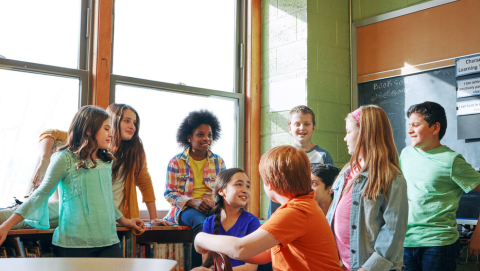Please give us feedback on one of our weekly question and answer articles. We value your time so the evaluation will only take 3 minutes or less, we promise!
Take the Survey »Benefits of Social Emotional Learning for Youth
By Samantha Everitt, Sanpete County Extension Intern, Sarah Everitt, Sanpete County Extension Intern, Livia Cornelsen, Sanpete County Extension Intern, Shannon Cromwell, Extension Associate Professor

Social emotional learning (SEL) is important for successful interactions and coping throughout the lifespan and has many benefits for youth. SEL applies to the development of self-awareness, self-control, self-regulation, and responsible decision-making skills, all of which are essential for positive youth development (Alber, 2021). Social emotional learning is valuable for children and their outlooks on life, as well as the development of problem-solving skills and perseverance in everyday activities. Below are five important benefits of SEL and the effects it has on youth development.
Five Benefits of SEL for Youth
- Collaboration – Communication and teamwork are essential to the lives of all children and youth. As they learn about collaborating with others around them, they gain these skills and begin to understand and share their emotions, as well as recognize the cause and effect of their feelings (Taylor et al., 2017).
- Leadership – As youth begin to understand how to express their emotions, they can reach out and help their peers do the same. Leadership includes not only standing in front of a crowd, but the willingness to listen and give aid to others. Youth can develop awareness skills that not only reinforce confidence in what they are tasked with, but also understand and see the needs of those around them to encourage teamwork and strong group work ethic (Jones et al., 2017).
- Perspective – Youth begin to develop an awareness of others around them and learn to look beyond themselves. As youth are involved in SEL, they can create a connection between their emotions and their daily actions and how these influence their peers (Devaney & Moroney, 2018; Jones et al., 2017).
- Problem Solving – Youth increase responsible decision-making skills by learning to regulate their emotions and gaining control over the situation in a positive manner. Understanding emotions provides youth with the ability recognize and express their emotions so they can make positive choices when dealing with difficult situations (Young et al., 2019).
- Individuality – SEL encourages uniqueness and diversity by teaching youth how to accept one’s “self” and love who they are as an individual. Youth are able to gain confidence and develop positive self-perception (Prince et al., 2010; Taylor et al., 2017).
Social Emotional Learning in the Classroom or in the Family
An important part of teaching SEL skills is understanding the importance of adaptation (Alber, 2021). Social emotional learning revolves around how well youth are equipped to handle their emotions now and in the future. Often, youth do not understand their innate responses to situations and what their emotions mean; therefore, parents and educators are instrumental in helping youth to adapt to new emotions. Development of SEL skills can look different for each child, so figuring out the best approach for each individual youth is key to future development. Engaging youth in activities that promote encouragement, teamwork, and positive problem-solving techniques provides opportunities for youth to practice coping and emotional regulation skills (Young et al., 2019).
Social Emotional Learning is essential for the positive growth and development of youth. As they develop self-awareness, self-control, self-regulation, problem-solving skills, perseverance, and responsible decision-making, youth are able to reach their full potential and are geared to have happier, more successful futures.
Additional SEL Resources:
Hidden Gems Family Relationship Guides: https://extension.usu.edu/relationships/hiddengems/
Collaborative for Academic, Social, and Emotional Learning: https://casel.org/fundamentals-of-sel/
National Education Association: https://www.nea.org/professional-excellence/student-engagement/tools-tips/resources-social-emotional-learning-sel-and-student-and-educator-mental-health
References
- Alber, D. (2021). A little spot of feelings & emotions. Diane Alber Art LLC.
- Devaney, E. & Moroney, D. A. (2018). Social and emotional learning in out-of-school time: Foundations and futures. Information Age Publishing.
- Jones, S. M., Barnes, S. P., Bailey, R., & Doolittle, E. J. (2017). Promoting social and emotional competencies in elementary school. The Future of Children, 27(1), 49-72.
- Prince, K. C., Ho, E. A., & Hansen, S. B. (2010). Effects of a school-based program to improve adaptive school behavior and social competencies among elementary school youth. Journal of Research in Character Education, 8(2), 39-59.
- Taylor, R. D., Oberle, E., Durlak, J. A., & Weissberg, R. P. (2017). Promoting positive youth development through school-based social and emotional learning interventions: A meta-analysis of follow-up effects. Child Development, 88(4), 1156-1171.
- Young, K. S., Sandman, C. F., & Craske, M. G. (2019). Positive and negative emotion regulation in adolescence: Links to anxiety and depression. Brain Sciences, 9(4), 1-20.

